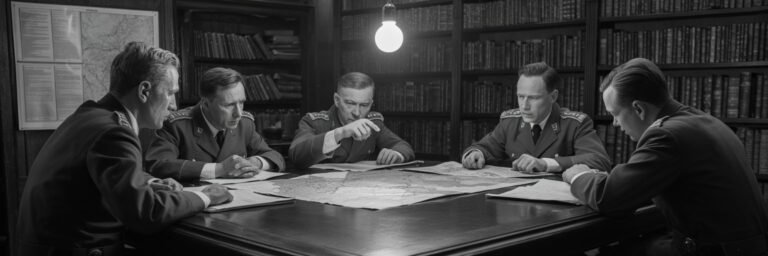INTRODUCTION
In the annals of time, few events have had such a profound and global impact as World War II. The entire world was embroiled in a terrible conflict, one that claimed millions of lives and transformed societies and cultures. While the causes of World War II are usually well documented, the reasons for its collapse are far more complex, intertwined with numerous geopolitical, socio-economic, and military factors. This monumental event led to the shaping of the world as we know it today, and hence, understanding what led to its collapse and the inherent implications are fundamental to appreciate the consequent global dynamics.
HISTORICAL BACKGROUND
No informed study of the collapse of World War II can exist in isolation without referring to the pivotal events that transpired during the 1940s. After six devastating years of war, the global conflict began to tip conclusively in the Allied forces’ favor by late 1944. This period was marked by the military might of the United States, the Soviet Union’s resilience, and the declining power of the Axis forces—Germany, Japan, and Italy. With D-Day in June 1944, the allied forces gained a significant stronghold in Western Europe. The Battle of the Bulge marked the last major German offensive on the Western Front, eventually yielding a significant blow to the German forces.
THEORIES AND INTERPRETATIONS
Nowhere, perhaps, is the complexity of analyzing historical events more evident than in deciphering what led to the collapse of World War II. Some academics argue that geopolitical factors were the central cause of the war’s resolution, while others point to the decisive military victories and tactics of the Allied forces. Still, others emphasize the impact of socio-economic factors and diplomatic maneuverings.
A key theory posits that Germany’s defeat was a telling factor leading to the collapse. The Soviet Union pushing into Eastern Europe, and with the successful implementation of D-Day, Allies had managed to corner Germany by early 1945. The death of Hitler in April 1945 expedited the process of Germany’s surrender.
However, many historians also cite the devastating impact of the nuclear bombings of Hiroshima and Nagasaki in August 1945 as a deciding factor. Japan, the last standing member of the Axis forces, announced its unconditional surrender only few days after.
MYSTERIES AND CONTROVERSIES
The collapse of World War II, while a well-studied event, is not free of mysteries and controversies. The decision to drop two atomic bombs on Japan is still a contentious issue among historians. Some argue that it was unnecessary and inhumane, stating that Japan was already on the brink of surrender. Others maintain that the bombs brought a speedy end to the war, averting a planned Allied invasion and potentially saving more lives than it took.
Another lesser-known controversy involves the role of the Soviet Union in the Pacific theatre. Some suggest that the Soviet Union’s declaration of war on Japan played a crucial role in pushing Japan to surrender, more so than the nuclear bombings. This theory remains overshadowed by the dominant narrative of atomic bombs.
SYMBOLISM AND CULTURAL SIGNIFICANCE
The end of World War II symbolizes many things, each of which varies in significance depending on cultural and national perspectives. The Allied victory is often seen as a triumph of democracy and freedom over totalitarianism. Conversely, for many Germans, Italians, and Japanese, the end of the war signified defeat, occupation, and foreign imposition of democratic systems.
Moreover, the dropping of atomic bombs on Japan has been deeply ingrained in popular culture, symbolizing both the destructive potential of nuclear weapons and the horrors of war. This event prompted the world to seriously consider the ethical boundaries of warfare and the generation of a collective global deterrence towards nuclear warfare.
MODERN INVESTIGATIONS
Several modern investigations and studies into the collapse of World War II further complicate the established narratives. Technologies such as artificial intelligence have been utilized to analyze existing data and offer new insights. Some of these studies have highlighted the importance of logistical factors in the ultimate Allied victory.
Furthermore, new documents and archives are continually being declassified, shedding new light on the conflict, such as previously unknown diplomatic channels of communication between the Allies and Germany or Japan, adding depth and diversity to our understanding of the war’s end.
LEGACY AND CONCLUSION
The legacy of the collapse of World War II is omnipresent. The war’s end marked the beginning of the Cold War era and the formation of the United Nations. Logically, such transformative consequences carry forth lessons for contemporary geopolitics, diplomacy, and military strategy.
Conclusively, the collapse of World War II was not a simple consequence of a single event but a complex interplay of multitude factors. This complexity offers fertile ground for academic contemplation, ensuring that the end of World War II will continue to be scrutinized, interpreted, and taught in diverse ways for generations to come.
While we may never fully comprehend the complete reality of why and how World War II collapsed, the quest to understand allows us to reflect on human nature, global politics, warfare, peace, and perhaps, more importantly, how we can shape our future to avoid the devastating costs of such global conflicts.






